Autonomous Search of Radioactive Sources through Mobile Robots
Abstract
1. Introduction
2. Prior Work
2.1. Estimation of Source Parameter
2.2. Search Strategy
3. Analysis of Robotic Radiation Measurement Model
3.1. Radiation Measurement Principle
3.2. Error Analysis of Robotic Radiation Measurement Model
4. Unknown Radioactive Source Search Strategy
4.1. Search Strategy
4.2. Parameter Estimation of Radioactive Sources
5. Experimental Analysis and Discussion
5.1. Simulation Experiment and Analysis
- Two-dimensional barrier-free space. The size is 200 m × 200 m;
- Fixed static radioactive source. . The maximum measured value is specified when the robot movement direction ;
- Generate count measurements according to Equation (3) and Poisson distribution noise, where ;
- The measured value of environmental background radiation count is 1 cps;
- The calculation method of refers to the method of [29].
5.2. Real Experiment and Analysis
- The parameters of the G-M radiation detector are as follows: Measurement range—, energy response—, sensitivity—, relative error: ≤15%. The five sides of the cuboid are aluminum alloy shells, and the front panel material is plastic.
- Use the TurtleBot robot as the experimental search robot, as shown in Figure 4c. The robot is equipped with an Acer notebook, and the notebook is installed with the Ubuntu + ROS system.
- The hokuyo UTM-30 lidar sensor is used to establish an environment map in advance, that is, the environment map already exists during the radioactive source search experiment.
- Obtain the robot’s coordinates by reading the robot’s odometer information.
- Equation (1) is simplified as , and k is constant. The dose equivalent rate measured by the nuclear radiation detector at a distance of 1 m from the radioactive source is 10.45 and thus .
- According to literature [5], for Cs-137 with an average γ-ray energy of 0.662 , the energy response constant is 12,200 .
- The position coordinate of the radioactive source in the experiment is (6.4 m, 4.0 m, 0.5586 rad), the initial position of the robot is (0, 0, 0), and the number of particles is .
- Due to the control of radioactive sources in universities, the experiment is conducted in 12 m × 8 m indoors.
6. Conclusions
Supplementary Materials
Author Contributions
Funding
Acknowledgments
Conflicts of Interest
References
- IAEA Incident and Trafficking Database (ITDB), Incidents of Nuclear and Other Radioactive Material out of Regulatory Control. Available online: https://www.iaea.org/sites/default/files/20/02/itdb-factsheet-2020.pdf (accessed on 13 February 2020).
- Badhwar, G.D.; Atwell, W.; Badavi, F.F.; Yang, T.C.; Cleghorn, T.F. Space radiation absorbed dose distribution in a human phantom. Radiat. Res. 2002, 157, 76. [Google Scholar] [CrossRef]
- Yoshida, T.; Nagatani, K.; Tadokoro, S.; Nishimura, T.; Koyanagi, E. Improvements to the rescue robot quince toward future indoor surveillance missions in the fukushima daiichi nuclear power plant. In Field and Service Robotics; Yoshida, K., Tadokoro, S., Eds.; Springer: Berlin/Heidelberg, Germany, 2014; pp. 19–32. [Google Scholar]
- Howse, J.W.; Ticknor, L.O.; Muske, K.R. Least squares estimation techniques for position tracking of radioactive sources. Automatica 2001, 37, 1727–1737. [Google Scholar] [CrossRef]
- Gunatilaka, A.; Ristic, B.; Gailis, R. Radiological Source Localisation. Published by DSTO Defence Science and Technology Organisation, Australia. Available online: http://www.dsto.defence.gov.au/corporate/reports/DSTO_TR_1988.pdf (accessed on 1 July 2007).
- Rao, N.S.V.; Shankar, M.; Chin, J.C.; Yau, D.K.Y.; Srivathsan, S.; Iyengar, S.S.; Yang, Y.; Hou, J.C. Identification of Low-Level Point Radiation Sources Using a Sensor Network. In Proceedings of the 2008 International Conference on Information Processing in Sensor Networks, St. Louis, MO, USA, 22–24 April 2008; pp. 493–504. [Google Scholar]
- Cho, H.S.; Woo, T.H. Mechanical analysis of flying robot for nuclear safety and security control by radiological monitoring. Ann. Nucl. Energy 2016, 94, 138–143. [Google Scholar] [CrossRef]
- Morelande, M.; Ristic, B.; Gunatilaka, A. Detection and parameter estimation of multiple radioactive sources. In Proceedings of the 10th International Conference on Information Fusion, Quebec, AB, Canada, 9–12 July 2007; pp. 1–7. [Google Scholar]
- Ristic, B.; Gunatilaka, A.; Rutten, M. An information gain driven search for a radioactive point source. In Proceedings of the 10th International Conference on Information Fusion, Quebec, AB, Canada, 9–12 July 2007. [Google Scholar]
- Ristic, B.; Gunatilaka, A. Information driven localisation of a radiological point source. Inf. Fusion 2008, 9, 317–326. [Google Scholar] [CrossRef]
- Morelande, M.R.; Ristic, B. Radiological Source Detection and Localisation Using Bayesian Techniques. IEEE Trans. Signal Process. 2009, 57, 4220–4423. [Google Scholar] [CrossRef]
- Hite, J.; Mattingly, J.; Archer, D.; Willis, M.; Rowe, A.; Bray, K.; Carter, J.; Ghawaly, J. Localization of a radioactive source in an urban environment using Bayesian Metropolis methods. Nucl. Instrum. Methods Phys. Res. A Accel. Spectrom. Detect. Assoc. Equip. 2019, 915, 82–9321. [Google Scholar] [CrossRef]
- Meutter, P.D.; Hoffma, I. Bayesian source reconstruction of an anomalous Selenium-75 release at a nuclear research institute. J. Environ. Radioact. 2020, 218, 1062259. [Google Scholar] [CrossRef]
- Newaz, A.A.R.; Jeong, S.; Lee, H.; Ryu, H.; Chong, N.Y. UAV-based multiple source localization and contour mapping of radiation fields. Robot. Auton. Syst. 2016, 85, 12–25. [Google Scholar] [CrossRef]
- Lee, M. Radiation Source Localization Using a Gamma-ray Camera. Master’s Thesis, Carnegie Mellon University, Pittsburgh, PA, USA, 2018. [Google Scholar]
- Klimenko, A.V.; Priedhorsky, W.C.; Hengartner, N.W.; Borozdin, K.N. Efficient strategies for low-statistics nuclear searches. IEEE Trans. Nucl. Sci. 2006, 53, 1435–1442. [Google Scholar] [CrossRef]
- Ji, Y.Y.; Lim, T.; Choi, H.Y.; Chung, K.H.; Kang, M.J. Development and Performance of a Multipurpose System for the Environmental Radiation Survey Based on a LaBr3(Ce) Detector. IEEE Trans. Nucl. Sci. 2019, 66, 2422–2429. [Google Scholar] [CrossRef]
- Royo, P.; Pastor, E.; Macias, M.; Cuadrado, R.; Barrado, C.; Vargas, A. An Unmanned Aircraft System to Detect a Radiological Point Source Using RIMA Software Architecture. Remote Sens. 2018, 10, 1712. [Google Scholar] [CrossRef]
- Li, B.; Zhu, Y.; Wang, Z.; Li, C.; Peng, Z.R.; Ge, L. Use of Multi-Rotor Unmanned Aerial Vehicles for Radioactive Source Search. Remote Sens. 2018, 10, 728. [Google Scholar] [CrossRef]
- Cepeda, J.S.; Chaimowicz, L.; Soto, R.; Gordillo, J.L.; Alanís-Reyes, E.A.; Carrillo-Arce, L.C. A Behavior-Based Strategy for Single and Multi-Robot Autonomous Exploration. Sensors 2012, 12, 12772–12797. [Google Scholar] [CrossRef]
- Van Nguyen, T.T.; Phung, M.D.; Tran, Q.V. Behavior-based Navigation of Mobile Robot in Unknown Environments Using Fuzzy Logic and Multi-Objective Optimization. Int. J. Control Autom. 2017, 10, 349–364. [Google Scholar] [CrossRef]
- Ardiny, H.; Witwicki, S.; Mondada, F. Autonomous Exploration for Radioactive Hotspots Localization Taking Account of Sensor Limitations. Sensors 2019, 19, 292. [Google Scholar] [CrossRef]
- Ristic, B.; Morelande, M.; Gunatilaka, A. Information driven search for point sources of gamma radiation. Signal Process. 2010, 90, 1225–1239. [Google Scholar] [CrossRef]
- Masson, J.B.; Bailly Bechet, M.; Vergassola, M. Chasing information to search in random Environments. J. Phys. A Math. Theor. 2009, 42, 434009. [Google Scholar] [CrossRef]
- Lin, H.I.; Tzeng, H.J. Search strategy of a mobile robot for radiation sources in an unknown environment. In Proceedings of the International Conference on Advanced Robotics and Intelligent Systems (ARIS), Taipei, Taiwan, 6–8 June 2014; pp. 56–60. [Google Scholar]
- Lin, H.I.; Tzeng, H.J. Searching a radiological source by a mobile robot. In Proceedings of the International Conference on Fuzzy Theory and Its Applications (iFUZZY), Yilan, Taiwan, 18–20 November 2015; pp. 1–5. [Google Scholar]
- Li, J.G.; Cao, M.L.; Meng, Q.H. Chemical Source Searching by Controlling a Wheeled Mobile Robot to Follow an Online Planned Route in Outdoor Field Environments. Sensors 2019, 19, 426. [Google Scholar] [CrossRef]
- Monroy, J.; Ruiz-Sarmiento, J.R.; Moreno, F.A.; Melendez-Fernandez, F.; Galindo, C.; Gonzalez-Jimenez, J. A Semantic-Based Gas Source Localization with a Mobile Robot Combining Vision and Chemical Sensing. Sensors 2018, 18, 4174. [Google Scholar] [CrossRef]
- Ristic, B.; Skvortsov, A.; Gunatilaka, A. A study of cognitive strategies for an autonomous search. Inf. Fusion 2016, 28, 1–9. [Google Scholar] [CrossRef]
- Hutchinson, M.; Oh, H.; Chen, W.H. Entrotaxis as a strategy for autonomous search and source reconstruction in turbulent conditions. Inf. Fusion 2018, 42, 179–189. [Google Scholar] [CrossRef]
- Rahbar, F.; Marjovi, A.; Martinoli, A. An Algorithm for Odor Source Localization based on Source Term Estimation. In Proceedings of the International Conference on Robotics and Automation (ICRA), Montreal, QC, Canada, 20–24 May 2019; pp. 973–979. [Google Scholar]
- Song, C.; He, Y.; Lei, X. Autonomous Searching for a Diffusive Source Based on Minimizing the Combination of Entropy and Potential Energy. Sensors 2019, 19, 2465. [Google Scholar] [CrossRef] [PubMed]
- Bos, A.J.J. Fundamentals of Radiation Dosimetry. In AIP Conference Proceedings; Rosenfeld, A., Kron, T., Errico, F., Moscovitch, M., Eds.; American Institute of Physics: New York, NY, USA, 2011; pp. 5–23. [Google Scholar]
- Sullivan, C.J. Radioactive source localization in urban environments with sensor networks and the Internet of Things. In Proceedings of the IEEE International Conference on Multisensor Fusion and Integration for Intelligent Systems (MFI), Baden-Baden, Germany, 19–21 September 2016; pp. 384–388. [Google Scholar]
- Shor, Y.B. Statistical methods of analysis and quality control and reliability. In Soviet Radio; Moscow State University: Moscow, Russia, 1962. [Google Scholar]
- Majercika, S.M.; Littmanb, M.L. Contingent planning under uncertainty via stochastic satisfiability. Artif. Intell. 2003, 147, 119–162. [Google Scholar] [CrossRef][Green Version]
- Vergassola, M.; Villermaux, E.; Shraiman, B.I. Infotaxis’ as a strategy for searching without gradients. Nature 2007, 445, 406–409. [Google Scholar] [CrossRef]
- Silverman, B.W. Density Estimation for Statistical and Data Analysis; Chapman and Hall, CRC Press: Boca Raton, FL, USA, 1986. [Google Scholar]
- Gilks, W.R.; Richardson, S.; Spiegelhalter, D. Markov Chain Monte Carlo in Practice; CRC Press: Boca Raton, FL, USA, 1995. [Google Scholar]
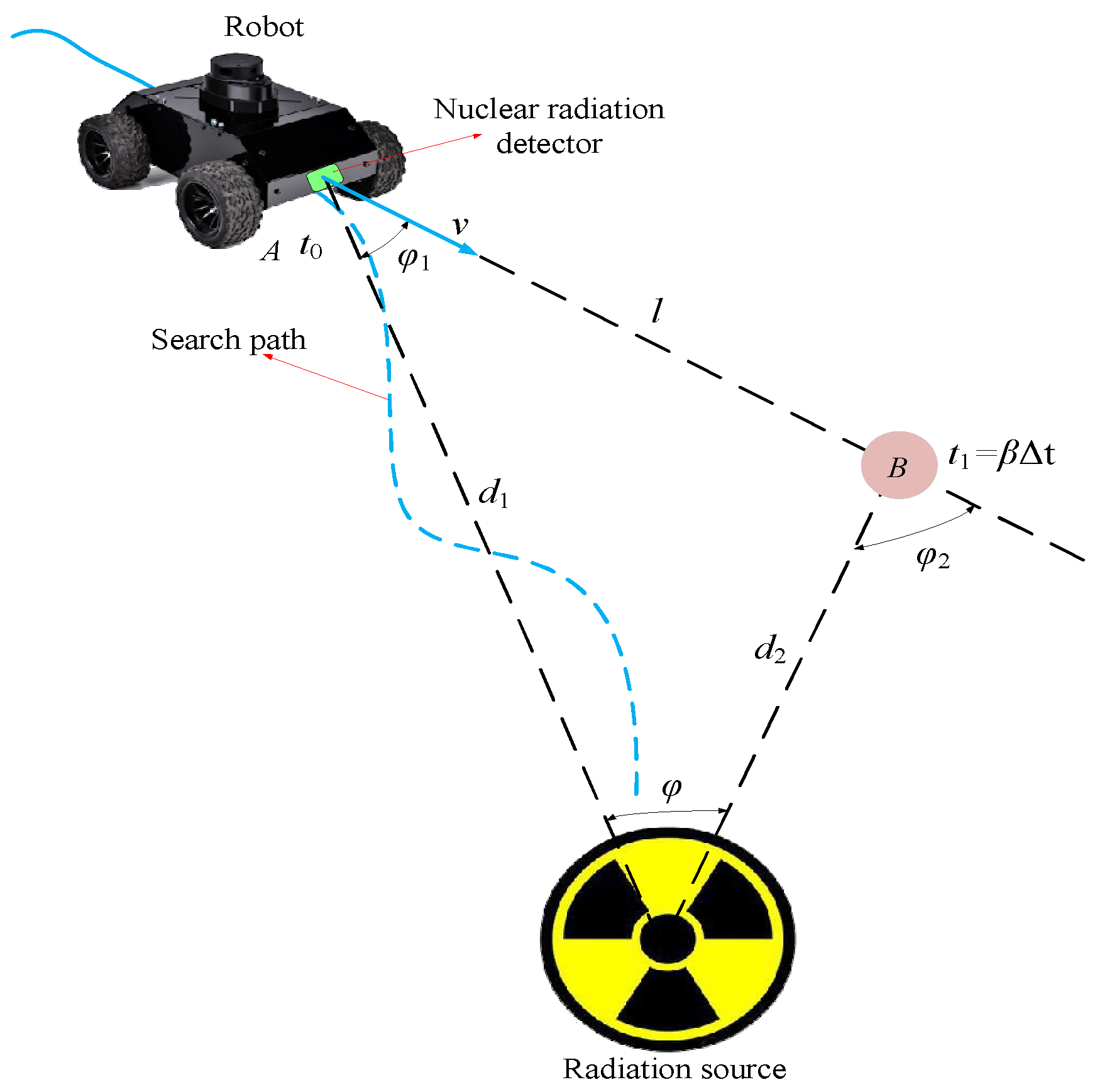
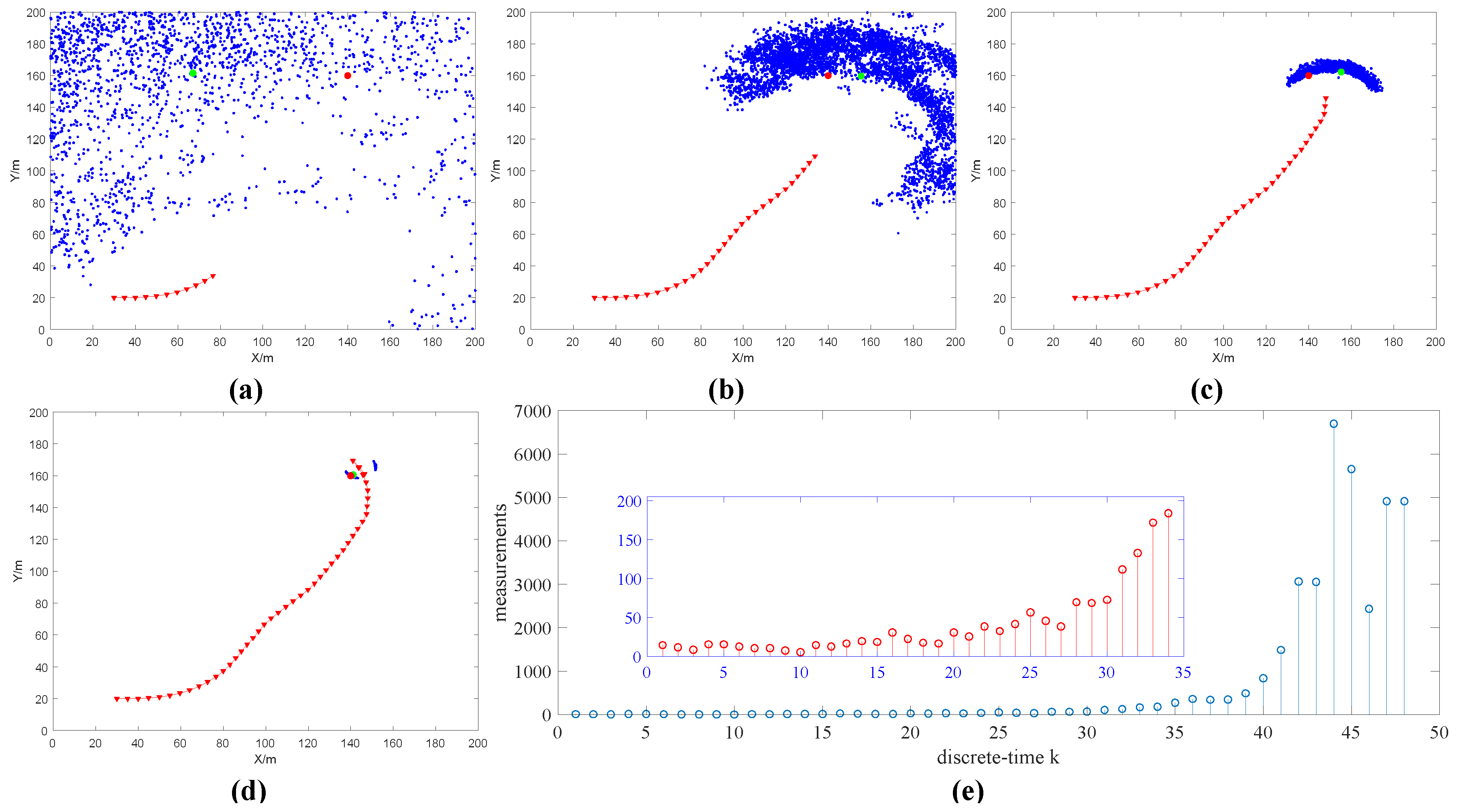
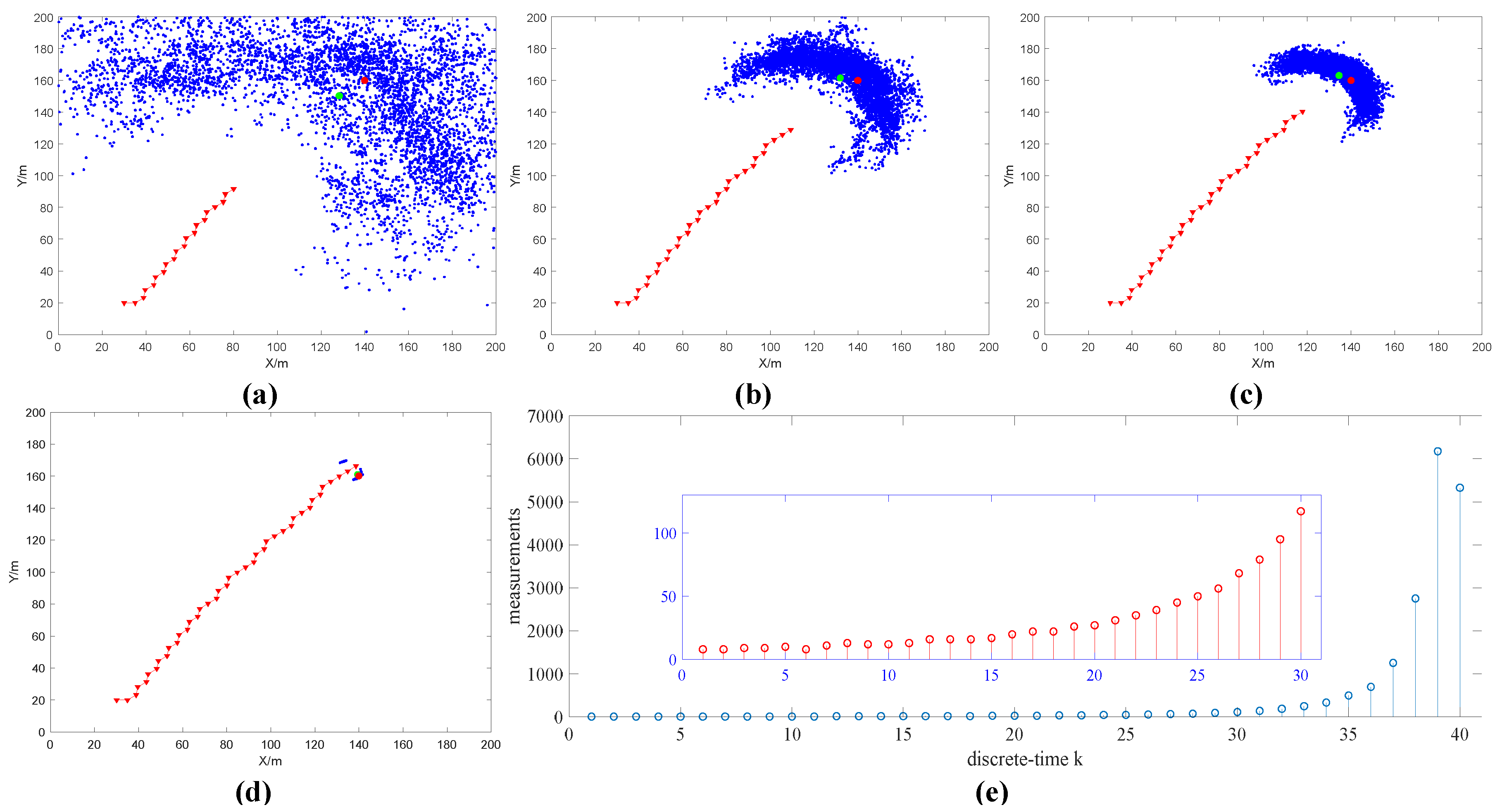
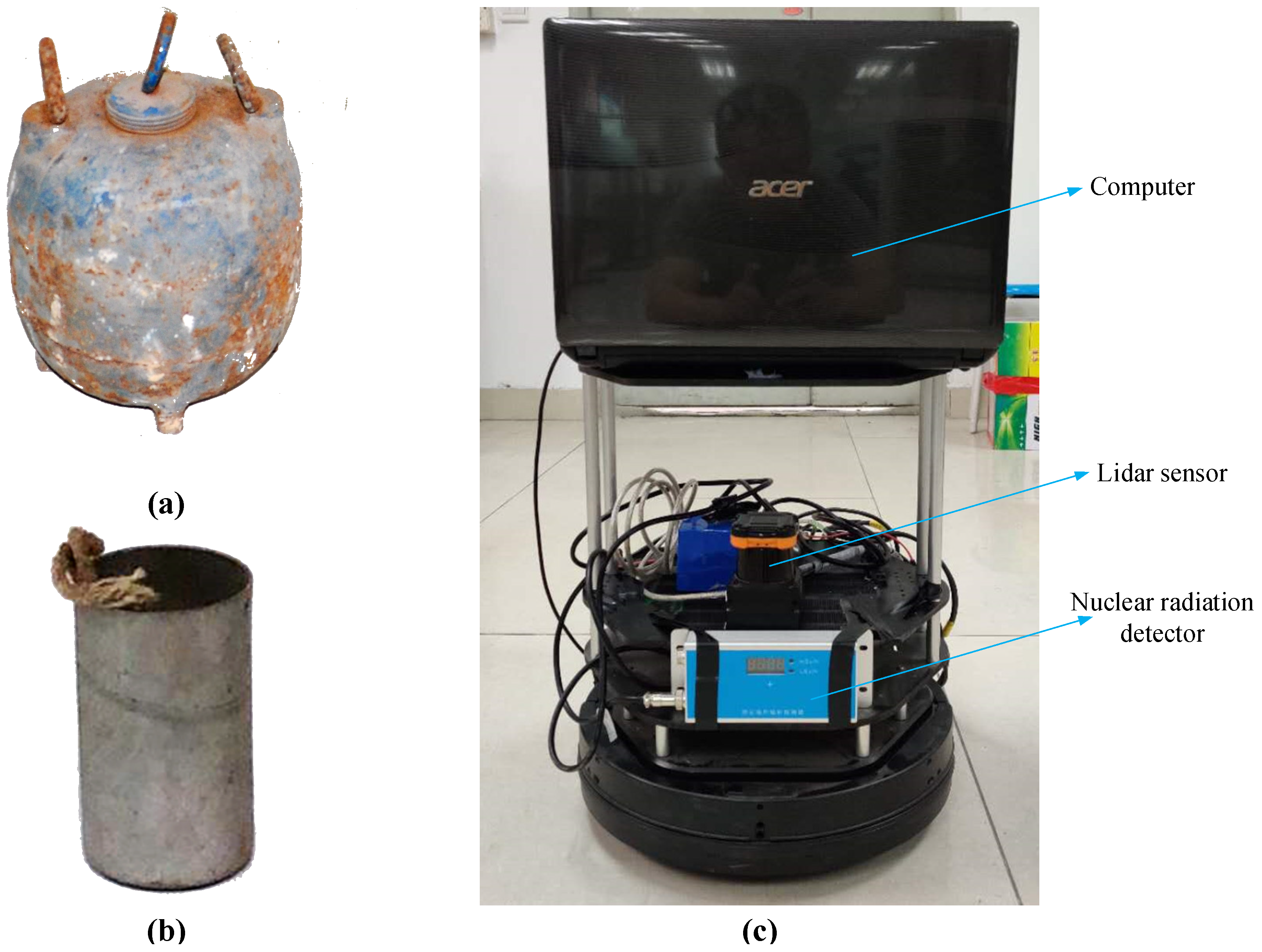
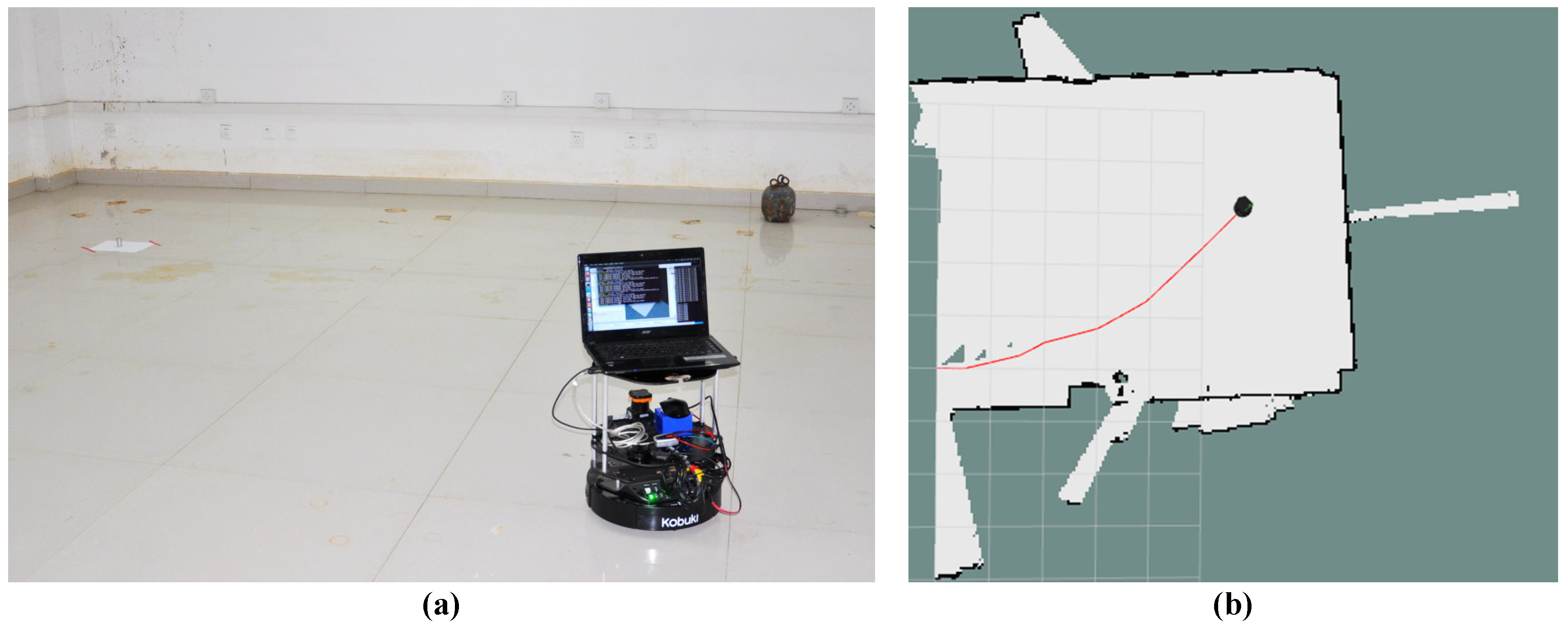
| Number | Iterations | Robot Final Position | Estimated Source Coordinates | Error | Estimated Source Size | Error |
|---|---|---|---|---|---|---|
| (146.56, 161.06) | (140.16, 159.99) | (0.16, 0.01) | 3.11 × 108 | 1.74 × 107 | ||
| (142.91, 155.04) | (140.98, 160.31) | (0.98, 0.31) | 2.97 × 108 | 3.11 × 106 | ||
| (137.60, 152.33) | (139.45, 159.58) | (0.55, 0.42) | 2.86 × 108 | 8.23 × 106 | ||
| (135.90, 153.19) | (139.45, 159.33) | (0.55, 0.67) | 2.89 × 108 | 5.33 × 106 | ||
| (135.98, 152.46) | (139.4, 159.79) | (0.6, 0.21) | 2.90 × 108 | 4.32 × 106 |
| Angular Velocity | Iterations | Robot Final Position | Estimated Source Coordinates | Error | Estimated Source Size | Error |
|---|---|---|---|---|---|---|
| (135.98, 152.46) | (139.4, 159.79) | (0.6, 0.21) | 2.90 × 108 | 4.32 × 106 | ||
| (137.34, 151.56) | (140.89, 159.05) | (0.89, 0.95) | 2.93 × 108 | 1.30 × 106 | ||
| (135.28, 154.00) | (139.07, 160.19) | (0.93, 0.19) | 2.87 × 108 | 7.03 × 106 | ||
| (138.68, 166.29) | (139.91, 160.01) | (0.09, 0.01) | 2.92 × 108 | 2.45 × 106 | ||
| (129.91, 167.67) | (140.33, 159.92) | (0.33, 0.08) | 3.02 × 108 | 7.90 × 106 |
| Number | Velocity | Iterations | Robot Final Position | Estimated Source Coordinates | Error | Estimated Source Size | Error |
|---|---|---|---|---|---|---|---|
| (7.25, 2.28) | (6.24, 4.05) | (0.16, 0.05) | 3.03 × 107 | 6.7 × 106 | |||
| (6.65, 2.56) | (6.44, 3.84) | (0.04, 0.16) | 3.47 × 107 | 2.3 × 106 | |||
| (6.18, 3.25) | (6.19, 3.74) | (0.21, 0.26) | 2.53 × 107 | 1.17 × 107 | |||
| (5.17, 3.2) | (6.37, 3.97) | (0.03, 0.03) | 3.31 × 107 | 3.9 × 106 | |||
| (5.42, 2.77) | (6.47, 3.94) | (0.07, 0.06) | 2.93 × 107 | 7.7 × 106 | |||
| (5.77, 3.14) | (6.27, 3.87) | (0.13, 0.13) | 3.01 × 107 | 6.9 × 106 | |||
| (5.29, 2.08) | (6.42, 4.03) | (0.02, 0.03) | 3.88 × 107 | 1.8 × 106 | |||
| (5.13, 2.25) | (6.34, 3.99) | (0.06, 0.01) | 3.44 × 107 | 2.6 × 106 | |||
| (4.55, 3.36) | (6.54, 4.1) | (0.14, 0.1) | 2.97 × 107 | 7.3 × 106 |
© 2020 by the authors. Licensee MDPI, Basel, Switzerland. This article is an open access article distributed under the terms and conditions of the Creative Commons Attribution (CC BY) license (http://creativecommons.org/licenses/by/4.0/).
Share and Cite
Huo, J.; Liu, M.; Neusypin, K.A.; Liu, H.; Guo, M.; Xiao, Y. Autonomous Search of Radioactive Sources through Mobile Robots. Sensors 2020, 20, 3461. https://doi.org/10.3390/s20123461
Huo J, Liu M, Neusypin KA, Liu H, Guo M, Xiao Y. Autonomous Search of Radioactive Sources through Mobile Robots. Sensors. 2020; 20(12):3461. https://doi.org/10.3390/s20123461
Chicago/Turabian StyleHuo, Jianwen, Manlu Liu, Konstantin A. Neusypin, Haojie Liu, Mingming Guo, and Yufeng Xiao. 2020. "Autonomous Search of Radioactive Sources through Mobile Robots" Sensors 20, no. 12: 3461. https://doi.org/10.3390/s20123461
APA StyleHuo, J., Liu, M., Neusypin, K. A., Liu, H., Guo, M., & Xiao, Y. (2020). Autonomous Search of Radioactive Sources through Mobile Robots. Sensors, 20(12), 3461. https://doi.org/10.3390/s20123461






